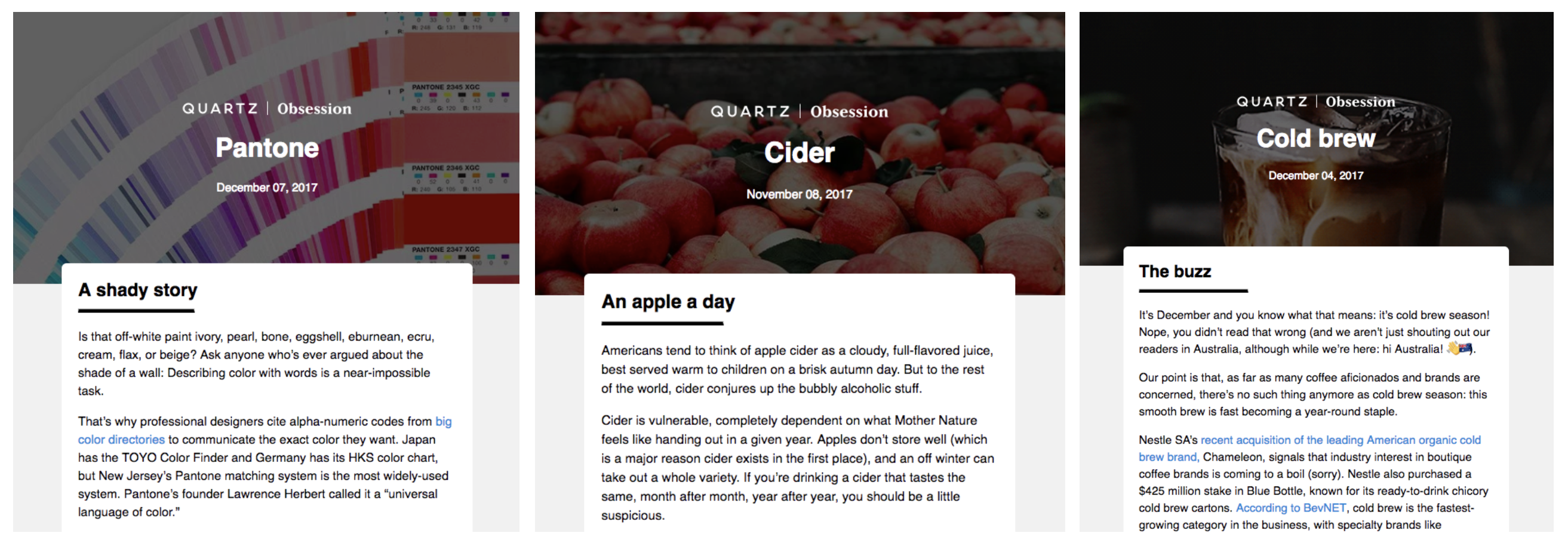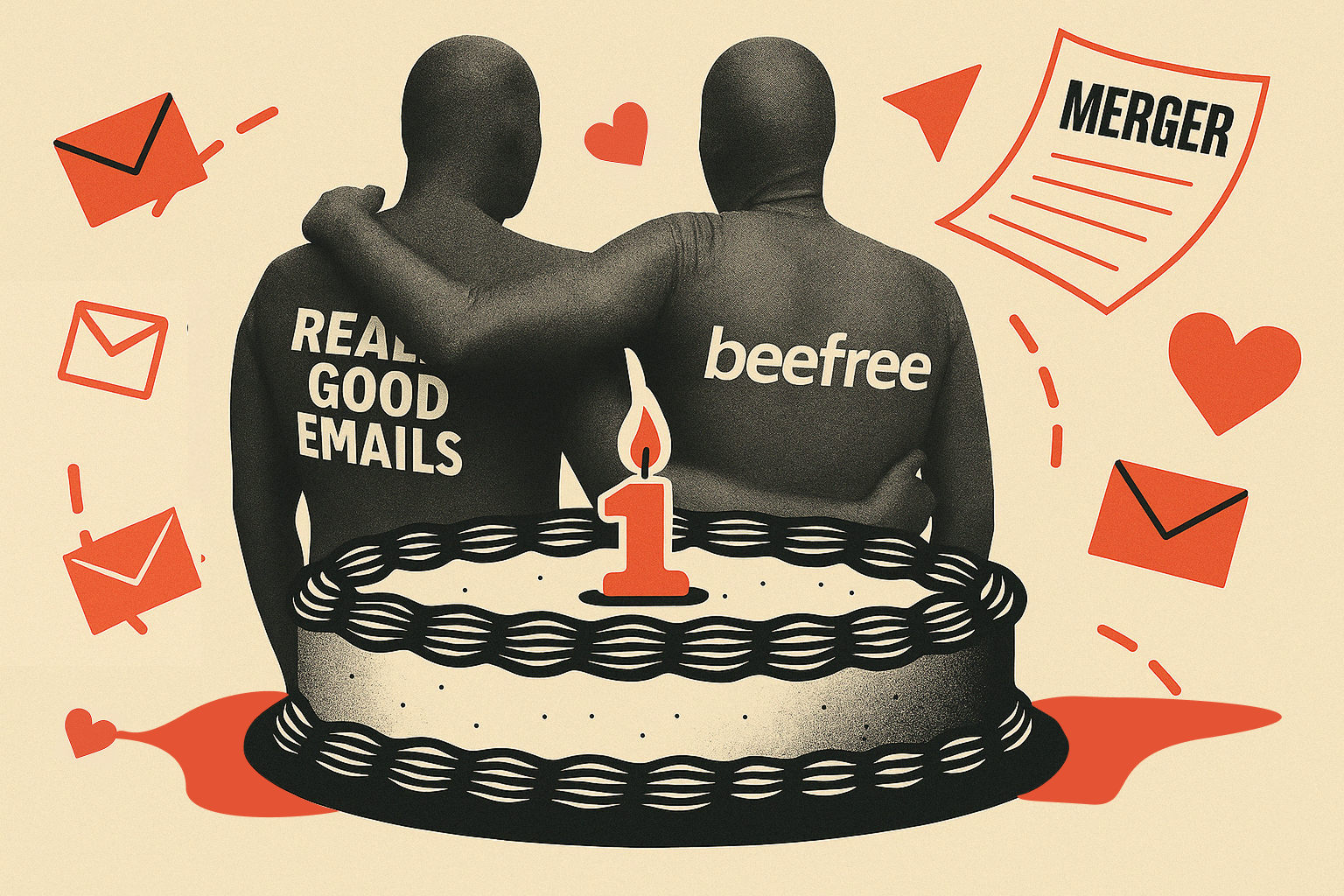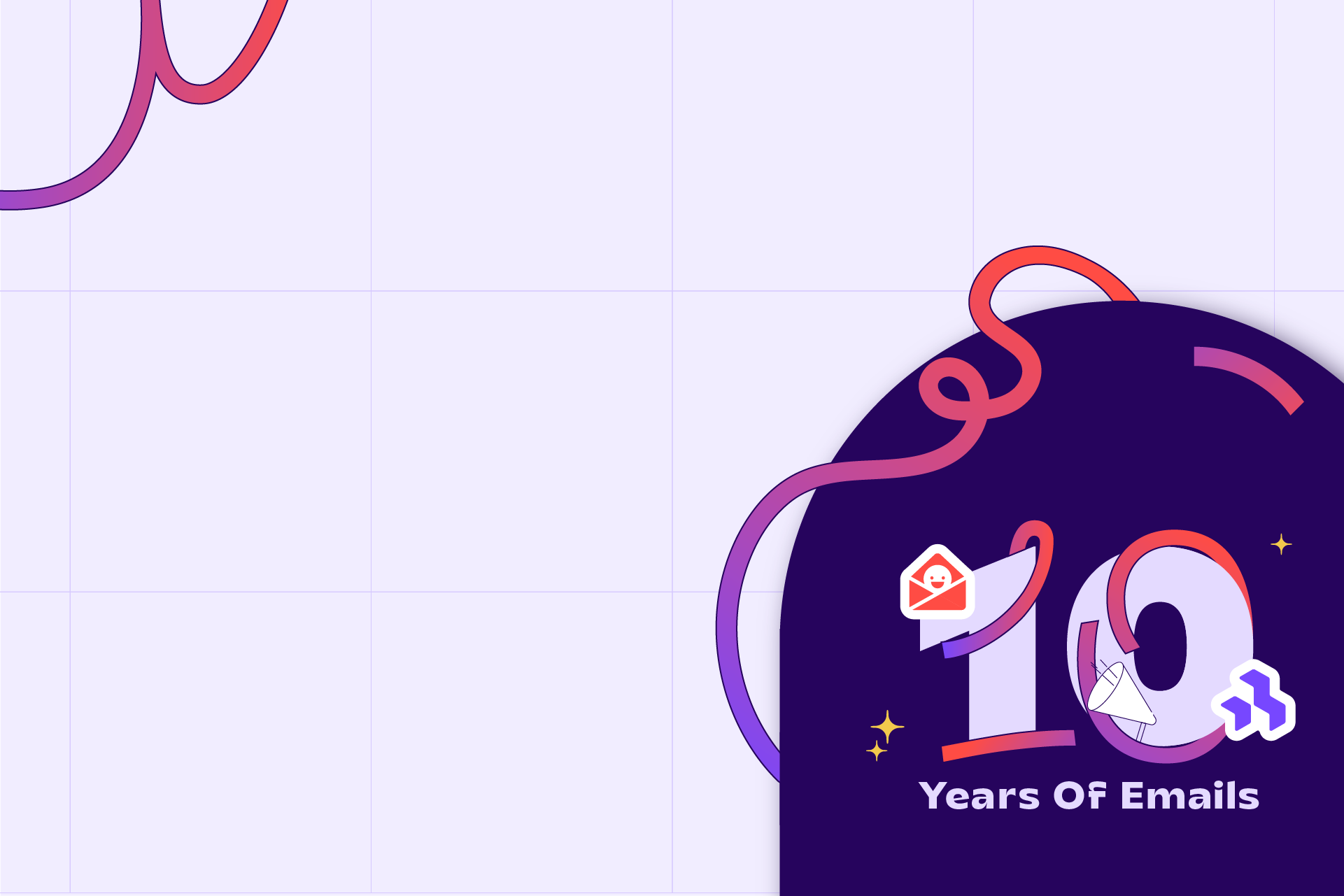Including an awesome range of elements (animated GIFs, infographics, videos, and embedded surveys and quizzes), Quartz delivers some of the most engaging and interactive newsletters we’ve ever seen. Design-wise, they’re clean and consistent. Content-wise, they’re smart, relevant, and well-written. And the topics of their Obsession emails are random and nerdy enough to give you a killer edge at trivia night.

Gamifying their newsletter has yielded tremendous results: growing to 700,000 subscribers, they doubled the size of their subscriber base in 2017. Like a boss.
While a recent Digiday article covered Quartz’ content strategies, we wanted more technical details on how they make their email magic. We spoke with several folks over at Quartz about their editorial processes, segmentation strategies, and the particular challenges of designing for news.
The Quartz newsletters really stand out with clean visual design and focus on content. Has it been worth the effort to design and build something that matches your brand?
Quartz is committed to developing news products that embrace coherence between editorial content and product design. The Quartz Obsession (a daily digression into the most fascinating corners of the global economy) was born out of this collaboration. Our readers love how focused this email feels, both editorially and visually, so it’s definitely paid off. — Eva Scazzero, associate product manager, Quartz

Do you feel that web page optimization is just as important as email optimization?
Quartz treats qz.com and newsletters as separate products so the optimization value is difficult to compare. Growth in both products is important but for different reasons. Given the nature of web platforms, qz.com has the potential for a wider audience, which is important for awareness. Newsletters have an opportunity to grow a deeply loyal readership, which is great for retention. Both are valuable and worth optimizing for. — Eva Scazzero, associate product manager, Quartz
How would you describe the differences in each newsletter type?
Quartz publishes five newsletters, they’re different in coverage and tone but share a common intelligent voice. Strategically, we tend to group them by daily or weekly inbox delivery in an effort to keep the user experience at the forefront. Our daily emails are the Quartz Daily Brief (which covers the most important and interesting news from the global economy) and Quartz Obsession. The Quartz Africa Weekly, Quartz Index, and Quartzy are our weekly emails.

How do you segment subscribers for these emails?
Segmentation of our subscriber lists are based on a reader’s region [and time zone]. If you live in Hong Kong you’ll be getting the email at a different time than someone living in London.
What has been your most engaged or most successful email? How do you measure success? What made this email work?
The most important key performance indicator is the total number of active subscribers we have per newsletter. We measure engagement based on a user’s open rate. We consider those who are consistently engaged with our emails, “active”. This metric comes from a belief that our content is worthy of being opened, and if it’s not we force ourselves to think about how we might improve.
Some of the recent Obsessions with high open rates include AIM, Pantone, The nostalgia economy, FICO, Jellyfish, and Concrete. Besides open rates, we look at the qualitative feedback we get from users who are replying to the email, or interacting on Twitter. Some topics provoke more conversation than others (dowsing actually proved a bit contentious) but if I get even one response that says “I didn’t think I was going to be interested in this topic, but I learned some fascinating things” I count that as a successful email.

What are the goals of the Quartz Obsession?
The goal of the Quartz Obsession newsletter is to provide readers with a deep dive into a fascinating corner of the global economy. We dig into phenomenons and surface stories that readers didn’t know they cared about. This happened to me when I read our email about Maple Syrup. — Eva Scazzero, associate product manager, Quartz
What is the hardest part of designing for news? How do you think that it differs from other industries? What are your unique challenges?
I would argue the integrity standards in journalism brings up interesting questions in our design process, more than in other industries. For example, how quickly image credits load may affect the perceived legitimacy of the story.
Strategizing for significant long-term growth while maintaining day-to-day product quality can be challenging. We invest heavily in deepening the loyalty of our existing readers and see value in that. As a product manager I’m aggressive about prioritizing the most urgent user-facing issues first before dealing with the backlog of email improvements.
One practical strategy we use to balance our short-term projects with our longer-term plans is by making space and time for design and editorial teams to meet. This is the best way our products are going to evolve, and we support that by adjusting our email product roadmap based on unanticipated needs or ideas. — Eva Scazzero, associate product manager, Quartz
What does your build-out process look like? Do you go in thinking layout first, content second?
How we’re setup right now, editors place their email content into a template that the product team has built for them. The product team is available for support but editors are pressing publish on all emails. We notice that giving editorial teams access to preview emails and the ability to play with elements before pressing send improves the quality of the product overall. — Eva Scazzero, associate product manager, Quartz
What’s one thing you thought you knew about email at the beginning that you now understand differently?
I think we misjudged how open the biggest fans of newsletters like the Quartz Daily Brief would be to new and different products, like the Quartz Obsession email, and our pop-up email products. There seems to be a common bond among our products that resonates with our most loyal fans. — Adam Pasick, push news editor, Quartz
Has the QZ news chatbot app impacted the newsletters in any way?

The app, released in early 2016, works as “an ongoing conversation about the news, sort of like texting: We’ll send you messages, photos, GIFs, and links, and you can tap to respond when you’re interested in learning more about a topic.”
I think you’ve seen some of the conversational tone and voice of the app leak into some of our emails, mostly at the margins, and there is certainly a lot of cross-pollination in terms of the stories we write and the staff that writes them. But it’s really important to us that each of the different emails and other editorial products has a distinct editorial voice and focus. — Adam Pasick, push news editor, Quartz
If you were going to hire an employee to work on your emails, what traits would you look for?
On an abstract level, I love working with those who adapt quickly to change and have a genuine desire to learn things outside their own discipline. These attitudes are helpful when unforeseen problems come up that demand to be understood, solved, and communicated quickly. — Eva Scazzero, associate product manager, Quartz
What digital tools do you use the most? What could you not live without? Top apps
Slack, Google products, Airtable for editorial planning, GIPHY.— Jessanne Collins, Obsession email editor
What’s a book you’d highly recommend?
I loved Quiet by Susan Cain. Reading it made me aware of my own needs as someone who thrives off both people and solitude. I like to think I’m a better product manager because I read it. — Eva Scazzero, associate product manager, Quartz
Lessons Learned: really good newsletters are awesome for building seriously loyal readers. (Thanks for being the best, by the way!). Besides that, segmenting for time zone is a good idea and so is regularly making space for editors and designers to meet. ’Cause growth is a team sport.






